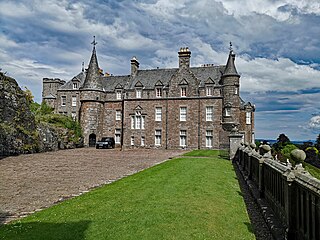
Drummond Castle is located in Perthshire, Scotland. The castle is known for its gardens, described by Historic Environment Scotland as "the best example of formal terraced gardens in Scotland." It is situated in Muthill parish, 4 kilometres (2.5 mi) south of Crieff. The castle comprises a tower house built in the late 15th century, and a 17th-century mansion, both of which were rebuilt in Victorian times. The gardens date to the 1630s, although they too were restructured in the 19th century. The formal gardens are protected as a category A listed building, and are included on the Inventory of Gardens and Designed Landscapes in Scotland. The tower house and mansion are both category B listed.
|caption = Entrance front of Balloch Castle |locmapin = Scotland West Dunbartonshire |map_caption = Location in West Dunbartonshire |coordinates = 56.013°N 4.583°W |designation1 = category a 14 May 1971 |designation1_number = LB123 |designation2 = Inventory of gardens and designed landscapes |designation2_date = 1 July 1987 |designation2_number = GDL00042 |designation2_offname = }}

Alloa Tower in Alloa, Clackmannanshire in central Scotland is an early 14th century tower house that served as the medieval residence of the Erskine family, later Earls of Mar. Retaining its original timber roof and battlements, the tower is one of the earliest, and largest, of Scottish tower houses, with immensely thick walls. It was designated as a scheduled monument in 1960 and is now owned by the National Trust for Scotland.

MacLellan's Castle in the town of Kirkcudbright, in Galloway, Scotland, was built in the late 16th century. It stands in the centre of Kirkcudbright, on the south side of the River Dee which flows into the Solway Firth. The L-plan castle was the residence of the MacLellan family from whom it derived its name. The family sold the castle in 1752, and from 1782 to 1912 it was held by the Earls of Selkirk. Today, the site is curated by Historic Environment Scotland.

Comlongon Castle is a tower house dating from the later 15th century or early 16th century. It is located 1 kilometre (0.62 mi) west of the village of Clarencefield, and 10 kilometres (6.2 mi) south-east of Dumfries, in south west Scotland. The original tower has been extended by the addition of a baronial style mansion, completed around 1900. Originally built by the Murrays of Cockpool, it remained in the Murray family until 1984. It was subsequently restored, having been vacant for some time, and the castle and mansion are now a hotel. As of 15 April 2019, the business side of Comlongon Castle has gone into Administration, consequently all weddings due and accommodation booked for after this date were cancelled, leaving the future of the castle uncertain.
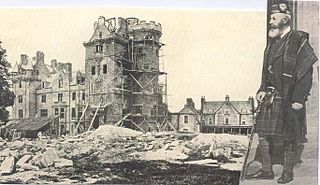
Beaufort Castle or Castle Dounie is a Baronial style mansion built in 1880 and incorporating older building work. It is situated on the right bank of the River Beauly near the town of Beauly in Inverness-shire and is 1 mile (1.6 km) north of Kiltarlity and 13 mi (21 km) west of Inverness. There has been a castle on the site since the 12th century. Beaufort is the traditional seat of the Lords Lovat.

Braal Castle is located by the River Thurso north of the village of Halkirk, in Caithness, northern Scotland. The ruined castle, which dates back to the mid-14th century, was originally known as the Castle of Brathwell.
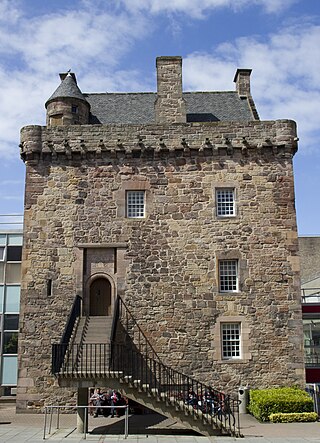
Merchiston Tower, also known as Merchiston Castle, was probably built by Alexander Napier, the 2nd Laird of Merchiston around 1454. It serves as the seat for Clan Napier. It was the home of John Napier, the 8th Laird of Merchiston and the inventor of logarithms, who was born there in 1550.

Melville Castle is a three-storey Gothic castellated mansion situated less than a mile (2 km) west-south-west of Dalkeith, Midlothian, near the North Esk.

Craignish is a peninsula in Argyll, on the west coast of Scotland. It lies around 25 miles (40 km) south of Oban, and 10 miles (16 km) north-west of Lochgilphead. The peninsula is around 5.5 miles (8.9 km) long, and is aligned along a north-east to south-west orientation, in common with much of the landform of coastal Argyll. To the south is Loch Craignish, which contains several small islands. To the north are the Slate Islands, with the island of Shuna closest. Jura is only 3 miles (4.8 km) west of Craignish Point, the southern tip of Craignish.

Finavon Castle lies on the River South Esk, about a quarter of a mile south of Milton of Finavon village and five miles to the north-east of Forfar in Angus, Scotland. The name is applied both to a ruined 17th-century castle, as well as the 19th-century mansion house 130m to the west.
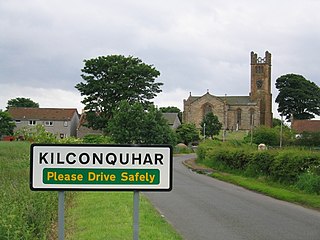
Kilconquhar is a village and parish in Fife in Scotland. It includes the small hamlet of Barnyards. It is bounded by the parishes of Elie, Ceres, Cameron, St Monans, Carnbee, Newburn and Largo. It is approximately 9 miles from north to south. Much of the land is agricultural or wooded. The village itself is situated inland, north of Kilconquhar Loch. Also in the civil parish are Colinsburgh and Largoward, the latter since 1860 being a separate ecclesiastical parish.

Fasque, also known as Fasque House or Fasque Castle, is a mansion in Aberdeenshire, Scotland, situated near the village of Fettercairn, in the former county of Kincardineshire.
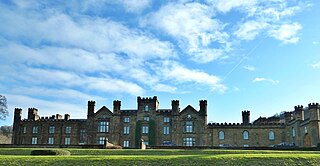
Wilton Castle is an early 19th-century mansion, built on the site of a medieval castle, now converted into residential apartments, situated at Wilton, in Redcar and Cleveland, North Yorkshire, England. It is a Grade II listed building.

Knock Castle is a private residence on the outskirts of Largs, on the west coast of Scotland. It was built by the boat-building Steele family in 1851, with a further wing added in the early twentieth century. The restored seventeenth century Knock Old Castle is within the grounds.

Saltoun Hall is an historic house standing in extensive lands off the B6355, Pencaitland to East Saltoun road, about 1.5 miles from each village, in East Lothian, Scotland. The house is reached by way of an impressive gateway and is situated at grid reference NT461685.

Calgary Castle, also known as Calgary House, is a 19th-century castellated Gothic mansion at Calgary on the Isle of Mull, Scotland. The mansion faces Calgary Bay on the west coast of the island, around 13 kilometres from Tobermory. It is a category B listed building.

Seton Castle is an 18th-century Georgian castle in East Lothian, Scotland. The castle was Robert Adam's final project in Scotland.

Calderwood Castle was located in East Kilbride, Scotland. The castle was situated near the banks of the Rotten Calder Water in what is now Calderglen Country Park. Most likely constructed in the early to mid fifteenth century by the Maxwell family, the original peel tower collapsed in 1773. It was replaced by an extension to a large 18th-century country house called Calderwood House, which has itself since been demolished along with a later 1840s Gothic Revival addition.
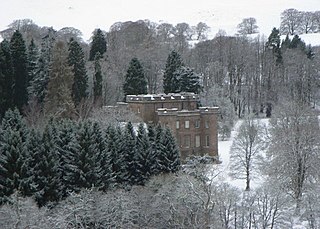
Monzie Castle is a castellated mansion, near Monzie in Perth and Kinross, Scotland that incorporates an L-plan, early 17th-century building that was enlarged in 1797–1800. It is a category A listed building.



















